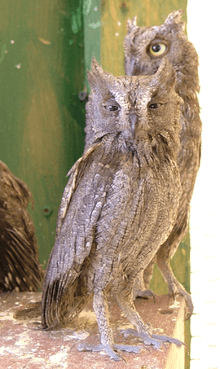Eurasian scops owl
The Eurasian scops owl (Otus scops), also known as the European scops owl or just scops owl, is a small owl. This species is a part of the larger grouping of owls known as typical owls, Strigidae, which contains most species of owl. The other grouping is the barn owls, Tytonidae. The scientific name is from the Latin otus for an eared owl and Ancient Greek skopos, "watcher".[3]
| European scops owl | |
|---|---|
%2C_Kalloni%2C_Lesvos%2C_Greece%2C_19.04.2015_(16773748434).jpg) | |
| Scientific classification | |
| Kingdom: | Animalia |
| Phylum: | Chordata |
| Class: | Aves |
| Order: | Strigiformes |
| Family: | Strigidae |
| Genus: | Otus |
| Species: | O. scops |
| Binomial name | |
| Otus scops | |
 | |
| Range of O. scops Breeding Resident Passage Non-breeding | |
| Synonyms | |
Distribution
This bird breeds in southern Europe eastwards into western and central Asia. It is migratory, wintering in southernmost Europe and sub-Saharan Africa. It is rare any distance north of its breeding range, usually occurring as a spring overshoot. It is unlikely that this nocturnal owl would be found outside the breeding season when it is not calling. It breeds in open woodland, parks and gardens. It lays 3-6 eggs in a tree hole.
Description
This is a small owl, and at 19–21 cm (7.5–8.3 in) in length and a 47–54 cm (19–21 in) wingspan is not as large as the little owl. Body mass ranges from 64 to 135 g (2.3 to 4.8 oz).[4] The scops owl perches upright and shows small ear tufts. It is predominantly grey-brown in colour, with paler face, underparts and shoulder line. This species has a strong direct flight on long narrow wings, reflecting its migratory habits.
Behaviour
The call is a deep whistle given by both sexes. It is similar to the call of the midwife toad.
References
- BirdLife International (2012). "Otus scops". IUCN Red List of Threatened Species. 2012. Retrieved 26 November 2013.CS1 maint: ref=harv (link)
- For Scops giu see for instance: Powys, 4th Baron Lilford, Thomas Littleton; Salvin, Osbert; Newton, Alfred; Keulemans, John Gerrard (1885). Coloured figures of the birds of the British Islands. 1. London: R.H. Porter. pp. 98f. OCLC 1029665771. Retrieved 2020-05-15.
- Jobling, James A (2010). The Helm Dictionary of Scientific Bird Names. London: Christopher Helm. pp. 286, 351. ISBN 978-1-4081-2501-4.
- CRC Handbook of Avian Body Masses by John B. Dunning Jr. (Editor). CRC Press (1992), ISBN 978-0-8493-4258-5.
External links


- BSC-EOC.org, Avibase, includes link to Flickr Hand Guide images.
- Owlpages.com
- Ageing and sexing (PDF; 5.8 MB) by Javier Blasco-Zumeta & Gerd-Michael Heinze
- Recordings of vocalisation on Xeno-canto
- Otus scops in the Flickr: Field Guide Birds of the World

